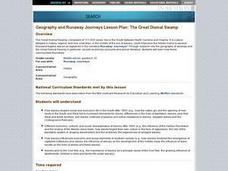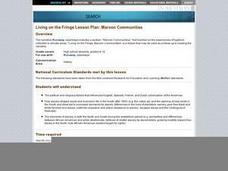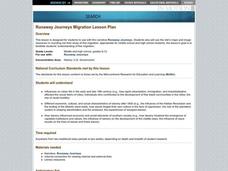Curated OER
The Underground Railroad (Fugitive Slave Act of 1850)
Students read and discuss the Fugitive Slave Act of 1850. They listen to the story of Reverend John Rankin, a reverend who openly broke the law to help free escape. They evaluate and debate the morality or immorality of breaking the...
Civil War Trust
Uncle Tom's Cabin
Through a careful reading and examination of Harriet Beecher Stowe's Uncle Tom's Cabin, scholars take part in grand conversations about the novel's contents, slavery, and the impact the book had on it. Furthermore,...
Curated OER
Fugitive from Labor Cases:
Learners examine the cases of Henry Garnett and Moses Honner, both of the 1850s. Students analyze the political climate building up to the Civil War through the lens of these similar cases with different outcomes.
Digital Public Library of America
The Underground Railroad and the Fugitive Slave Act of 1850
Escaping Enslaved people attempting to escape didn't need a ticket to ride on the Underground Railroad. Here is a packet of primary sources that reveal the kind of courage and determination they did need to face the challenges to gain...
National First Ladies' Library
Riding the Underground Railroad
Young historians explore the underground railroad and life as a slave during the Civil War. After internet research, they discuss the hazards of travel as a slave and the benefits of freedom. Individually, students write a short story...
Curated OER
Fugitive Slave Act of 1850
Students take a closer look at the Fugitive Slave Act of 1850. In this slavery lesson, students examine an image and read excerpts from Uncle Tom's Cabin as well as the Fugitive Slave Act of 1850. Students discuss their analysis of the...
Curated OER
African-American History and Culture in the English Classroom
Ninth graders identify and recognize characteristics of nonfiction in literary works, explore language and culture of Gullah people, compare and contrast purposes of spirituals and quilts in terms of their relationships to escape from...
Curated OER
THE GREAT DISMAL SWAMP
Students analyze how slavery shaped social and economic life in the South after 1800, the different economic, cultural, and social characteristics of slavery after 1800, and slavery both prior and after the Civil War.
Curated OER
Whitewashing Southern History
Students discuss the fact and fiction of slavery in the South. After viewing a video on two New Orleans plantations, they determine the accuracy of the facts presented. In the computer lab, they visit various sites and examine which ones...
Curated OER
Three Coffles Lesson Plan
Middle schoolers read about the slave trade in primary source documents. They discuss differences and commonalities in experiences. They write prose or poetry from the point of view of one of the figures from the reading and create a...
Curated OER
Fugitive Slave Narratives
Learners analyze the ways slavery shaped social and economic life in the South after 1800, the different economic, cultural, and social characteristics of slavery after 1800, and the ending of the Atlantic slave trade.
Curated OER
Maroon Communities
Students examine political and religious factors that influenced English, Spanish, French, and Dutch colonization of the Americas, how slavery shaped social and economic life in the South after 1800, and elements of slavery during the...
Curated OER
RUNAWAY JOURNEYS MIGRATION
Pupils analyze the influences on urban life in the early and late 19th century, different economic, cultural, and social characteristics of slavery after 1800, the rise of racial hostility, and the ending of the Atlantic slave trade.
Curated OER
Who is Harriet Tubman?
Second graders read A Picture of Harriet Tubman, by David A. Adler. In this Harriet Tubman lesson, 2nd graders explore the concept of slavery and discover how Harriet helped free slaves in the past. The book is read out loud. They...
Curated OER
What Does This Song Really Say?
Students investigate communication by analyzing lyrics from a song. In this music arts lesson, students discuss slavery, the Underground Railroad and African American traditions while listening to a song called "This Train." Students...
Curated OER
Underground Railroad Role Play
Students experience what the Underground Railroad was really like by role-playing as escaping slaves. They must travel to the North Star until they cross an imaginary line into Canada.
Curated OER
Who Got Away? 18th Century Runaway Slaves
Students read runaway slave advertisements while completing a chart to determine whether slaves successfully escaped. For this US history lesson plan, students must research the Virginia Runaways Digital Project and use the given links...
Curated OER
Abolitionists in U.S. History
Learners read and discuss excerpts from the writings of Henry David Thoreau, Frederick Douglass and Sarah Parker Redmond. They compare and contrast the views of the three abolitionists concentrating on the experiences and reasons for...
Curated OER
Underground Railroad
Fourth graders reflect on their knowledge of the Underground Railroad. In this slavery lesson, 4th graders discuss slavery and watch a video. Students complete a K-W-L chart after discussion and reading, as well as, a...
Curated OER
Underground Railroad Activity
Eighth graders practice their interviewing skills as they learn about the Underground Railroad. For this slavery lesson, 8th graders discuss the existence and operation of the railroad. Students then interview one another in the personas...
Curated OER
Language Arts: Ran Away Story
Students write fictional stories about the search for a runaway slave. Their tales are based on the search by William Harris from South Carolina for his slave, George, in Detroit. Students include the answers to teacher-provided...
Curated OER
WEEK TWO
Students research in books and on the Internet on the Underground Railroad. They work on a constructivist project to promote both group collaboration and individual creativity. Students are given an authentic task: to create a museum...
Curated OER
Planning an Escape
Students identify characteristics of runaway slaves in the 18th century, Generalize about reasons slaves ran away, and construct plan of how a slave might be successful in running away.
Curated OER
From Slavechild to Freedom
Third graders read excerpts from 5 slave narratives and study and compare/contrast their families, living conditions, duties, methods of escape and destinations. In this history lesson, 3rd graders get into small groups to present their...

























